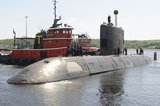Hensoldt wins order to provide more TRS-3D multi-mode naval radars to US Coast Guard
Hensoldt's TRS-3D naval radar equips USCG National Security Cutters. (Photo: USCG)
The TRS-3D Baseline D, with the US designation AN/SPS-75, utilises gallium nitride and solid-state emitter technology to deliver the same performance while improving reliability and options for future development.
Hensoldt’s TRS-3D radars have been aboard every NSC since the programme’s inception. TRS-3D is a three-dimensional, multi-mode naval radar for air and surface surveillance, target acquisition, self-defence, gunfire support and aircraft control. It automatically detects and tracks all types of air and sea targets, alleviating crew workload requirements.
The TRS-3D/AN/SPS-75 radar is a modular, countermeasure-resistant, medium-range air and surface surveillance system designed for automatic detection, track initiation and tracking of all types of air and sea targets
Related Articles
Latest NSC gets TRS-3D Baseline D radar
With the latest signal processing technologies, it is suited for detection of low-altitude and fast-moving objects and asymmetric threats under severe environmental conditions.
As well as the USCG, the system is also in service with the defence forces of Denmark, Finland, Germany, Malaysia, Norway and Spain as well as aboard some USN Freedom-class Littoral Combat Ships.
Related Equipment in Defence Insight
More from Naval Warfare
-
![First made-in-Finland US Coast Guard Arctic Security Cutter to be delivered in 2028]()
First made-in-Finland US Coast Guard Arctic Security Cutter to be delivered in 2028
The first Arctic Security Cutter will be built by Rauma Marine Constructions to be deployed in the US Arctic waters.
-
![Is the US Navy’s Golden Fleet initiative achievable?]()
Is the US Navy’s Golden Fleet initiative achievable?
The effort to provide the US Navy with Trump-class battleships might face financial, production and doctrinal obstacles.
-
![Will the US Navy surge production for OTH-WS missile?]()
Will the US Navy surge production for OTH-WS missile?
The USN is conducting a market search seeking additional sources capable of supplying 516 units of Over the Horizon – Weapons System Encanistered Missiles.
-
![How will SAFE shape naval procurement for Canada and its highest-receiving members?]()
How will SAFE shape naval procurement for Canada and its highest-receiving members?
Canada’s inclusion on the EU’s Security Action for Europe initiative is set to enhance the country’s defence procurement strategy with important implications for some of its naval programmes, while Poland and Romania have also secured significant SAFE funding.
-
![Maritime defence in the Mediterranean faces challenges from vulnerable land power]()
Maritime defence in the Mediterranean faces challenges from vulnerable land power
As an indispensable energy crossroads, the Mediterranean is at serious risk from grey zone disruption. As navies increasingly employ AI data centres, what happens when cutting-edge defence technologies rely on the very infrastructure most susceptible to hybrid tactics?






















